Reports on Plant Diseases |
RPD No. 705 - Downy Mildew of Grape
|
March 2001
|
[ Symptoms ] [ Disease
Cycle ] [ Control ] [ Table 1
]
|
Downy mildew, caused by the fungus Plasmopara viticola,
is probably the most serious disease of unsprayed grape foliage
in the Midwest. The disease occurs worldwide wherever the weather
during the growing season is humid and rainy, and temperatures are
cool to moderate. The optimum temperature for the development of
an epidemic of downy mildew is 64° to 76°F (18° to
24°C), a minimum of 54° to 58°F (12° to 13°C),
and a maximum of about 86°F (30°C).
Primary damage is through premature defoliation in the middle to
late summer that may result in abnormal fruit development (Figure
1). The fruit from vines that are seriously diseased has a low sugar
content. From 50 to 75 percent of the fruit crop may be destroyed
where the vines are not sprayed, a highly susceptible cultivar is
grown, and weather conditions are favorable for infection. Only
a few of the older leaves may develop symptoms if the growing season
has been hot and dry–unfavorable for the spread and growth
of the causal fungus–or if the grape cultivar is a resistant
one.
The downy mildew fungus attacks all common species of wild and
cultivated grapes (Vitis species). The European grape
(V. vinifera) is more susceptible than cultivated
American grapes, which have derived from native species. Other hosts
of the fungus include species of the closely related genus Parthe
nocissus, which includes Virginia-creeper (P. quinquefolia)
and Boston-ivy (P. tricuspidata).
Loss of leaves may not only affect that season's crop, it may also
affect the next season's crop by retarding cane maturation and decreasing
the amount of stored food reserves in the vine. In young vines,
this effect may cause death of the plant.
Back to Top
|
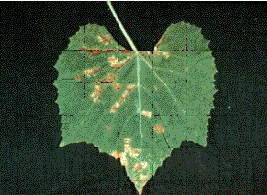
Figure
1.
Downy mildew on upper side of grape leaf.
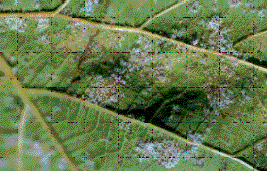
Figure
2.
Appearance of infection on underside of a leaf.
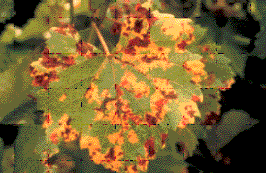
Figure
3.
Symptoms on upper surface of a leaf in autumn (R. Lafon)
|
Symptoms
Leaves
Very young infections are minute, greenish yellow, and translucent
"oily" spots that are difficult to see. The lesions enlarge, appearing
on the upper surface as angular to irregular, pale yellow to greenish
yellow spots with indefinite borders up to about 1/4 inch or more
in diameter (Figure 2.)
Older leaves in the center of the vine are the first to become
infected. Later, the disease spreads toward the young leaves near
the ends of the canes. On highly susceptible grape cultivars (see
Table 1), even the youngest leaves may die
and drop prematurely by autumn.
On Fruit
Two periods of fruit infection may occur during a growing season.
The first is when the berries are about the size of small peas.
If infected at that stage, the young fruit turns light brown and
soft, shatters easily, and in damp weather is frequently covered
with the white downy growth of the fungus. During the hot summer
months, little fruit infection normally occurs.
When the nights become cooler in the late summer and early autumn,
a second infection period may develop. Berries infected at this
time generally do not soften or form the downy mildew growth. Instead,
they stop growth, become leathery, turn a dull green, then dark
brown to brownish purple, wrinkle somewhat, and shatter easily.
In severe cases, the entire fruit cluster may decay. The berries
do NOT shrivel into "mummies" and turn black and hard as in black
rot.
On Shoots and Tendrils
Early symptoms appear as water-soaked, shiny depressions on which
a dense growth of whitish mildew appears. Young shoots are stunted,
thickened, and may be quite distorted (Figure 6). Such infected
shoots and tendrils turn brown and die.
|
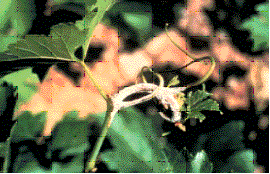
Figure
4.
Downy mildew symptoms on a shoot (R.C. Pearson).

Figure
5.
Downy mildew on young grape berries.
|
Disease Cycle
|
In the Midwest, the downy mildew fungus overwinters in infected
leaves on the ground, and occasionally in diseased fruit and shoots,
as thick-walled resting spores (oospores). Weathering and decomposition
of the grape tissues over one or two winters liberate the embedded
oospores. During rainy periods in the spring, the oospores germinate
at an optimum temperature of 68° to 77°F (20° to 25°C) to produce
microscopic spores (sporangia or conidia). The sporangia are disseminated
by wind, rain-splash, and by handling wet plants. In a film of moisture,
a sporangium may rarely form a germ tube; more commonly its contents
divide up to form up to 17 motile spores (zoospores or swarm spores).
After swimming about for a few minutes to half an hour, zoospores
come to rest and encyst; and in about 15 minutes, they produce germ
tubes that penetrate the lower surface of young leaves, shoots,
tendrils, and blossom clusters resulting in primary infections.
The fungus spreads through grape tissue by growing between the cells.
Food and water are obtained by globular structures (haustoria) that
invade the host cells in large numbers. The fungus masses within
the grape tissue; and when the nights are cool and damp, structures
form on the underleaf surfaces and on stems that are delicate, branched,
miniature, and treelike, called sporangiophores or conidiophores
(Figure 7). They grow out singly or, more often, in clusters of
4 to 6 (but up to 20) through natural openings (stomates) or, rarely,
by pushing directly through the epidermis. On the young fruit the
sporangiophores emerge through lenticels. Each sporangiophore produces
four to six branches at nearly right angles to the main stem, and
each side branch produces two, sometimes three, secondary branches.
Single, lemon-shaped sporangia (conidia) are formed at the tips
of the secondary branches. The sporangia are easily disseminated
by wind, rain, and by handling infected plants.
The sporangiophores, with their large numbers of terminally borne
sporangia, make up the downy mildew growth. If water is present
on grape tissue, the sporangia quickly germinate to produce large
numbers of motile zoospores that can result in secondary infections
throughout a vineyard and thus rapidly spread the disease. Young
lesions can be seen 4 to 12 days after infection on susceptible
grape cultivars while it takes up to 18 or 20 days on a resistant
plant. Spore germination, penetration, and infection can occur in
30 minutes to 2 hours at an optimum temperature of 50° to 60°F (10°
to 16°C) with a minimum of about 40°F (4°C). The sporangiophores
and sporangia of the downy mildew fungus are usually formed at night
and are most visible in early morning while the leaves, fruit, and
other infected parts are still damp.
Toward the end of the growing season, oospores are formed in the
old diseased leaves. To a lesser extent, oospores are also formed
in infected fruit and shoots. The formation of the overwintering
oospores completes the disease cycle.
|
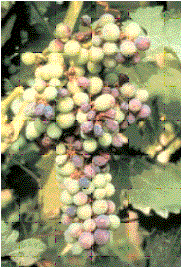
Figure
6.
Downy mildew on a developed cluster (R. Lafon).
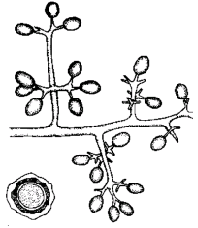
Figure
7.
Plasmopora viticola, the grape downy mildew pathogen, seen under
a high-power microscope. Thick-walled oospore (lower left). Remember,
branched sporangiophores bearing terminal, lemon-shaped sporangia
(L.Gray).
|
Back to Top
Control
Downy mildew is comparatively easy to control on most grape cultivars
when the foliage and fruit are kept protected by fungicide sprays. From
midseason on, downy mildew increases in importance while black rot becomes
less important.
- Properly space vines, and choose a planting site where the vines will
be exposed to all-day sun and good air circulation. Keep the vines off
the ground and properly tied.
- Prune vines severely each year during the dormant period. Select only
strong, healthy canes of the previous year's growth to produce the following
season's crop. Follow suggestions outlined in University of Illinois
Cooperative Extension Service Circular 935, "Growing Small Fruits
in the Home Garden". Remove the prunings, excess growth, overwintering
berries, leaves, and tendrils from the vineyard and, where possible,
burn them.
- Keep the fruit planting and surrounding areas free of weeds and tall
grass.
- Where feasible, cultivate the vineyard before budbreak to cover the
mummified berries. Diseased berries covered with soil cannot produce
spores to reach the developing vines.
- Grape cultivars differ in their susceptibility to downy mildew and
several other diseases. The reactions of almost 40 grape cultivars to
downy mildew and three other diseases are given in Table
1. Cultivars with large, juicy berries are the most susceptible
ones. In general, grapes that ripen late in the season will be affected
least. All commercial cultivars now grown in Illinois are sufficiently
resistant if adequately protected with a fungicide spray program during
prolonged rainy periods.
- Protective fungicide sprays are needed in wet seasons to protect the
developing new growth. Follow the grape spray schedule outlined in Illinois
Extension Circular 1145, "Home Fruit Pest Control". Thorough coverage
of all aboveground plant parts with each application is essential for
control and for successful fruit production. The important sprays for
downy mildew control are
- when the new shoots are 2 to 4 inches long or have four or five
leaves;
- just before bloom (new shoots 12 to 18 inches long);
and
- just after bloom, when the fruits have set.
After these three crucial sprays, applications should continue at about
10-day intervals as long as the weather is rainy and muggy. If it turns
dry, the sprays may be discontinued.
Downy mildew is NOT difficult to control if the cultural and chemical
practices outlined here are followed.
Table 1
|
Relative Disease Susceptibility and Chemical
Sensitivity of Grape Cultivars
|
|
The relative ratings in this chart apply
to an average growing season under conditions usually favorable
for disease development. Any given variety may be more severely
affected.
|
|
Variety
|
BR |
DM |
PM |
Bot |
Phom |
Eu |
CG |
ALS |
S[1] |
C[2] |
|
Aurora
|
+++ |
++ |
++ |
+++ |
+ |
+++ |
++ |
+++ |
No |
++ |
|
Baco Noir
|
+++ |
+ |
++ |
++ |
+ |
++ |
+++ |
++ |
No |
? |
|
Cabernet Franc
|
+++ |
+++ |
+++ |
+ |
? |
? |
+++ |
? |
No |
+ |
|
Cabernet Sauvignon
|
+++ |
+++ |
+++ |
+ |
+++ |
+++ |
+++ |
? |
No |
+ |
|
Canadice
|
+++ |
++ |
+ |
++ |
? |
? |
++ |
++ |
? |
? |
|
Cascade
|
+ |
+ |
++ |
+ |
++ |
++ |
+ |
? |
No |
? |
|
Catawba
|
+++ |
+++ |
++ |
+ |
+++ |
+ |
+ |
+ |
No |
++ |
|
Cayuga White
|
+ |
++ |
+ |
+ |
+ |
+ |
++ |
++ |
No |
+ |
|
Chambourcin
|
+++ |
+ |
++ |
++ |
? |
? |
++ |
? |
Yes |
? |
|
Chancellor
|
+ |
+++ |
+++ |
+ |
+++ |
+ |
+++ |
+++ |
Yes |
+++ |
|
Chardonel
|
? |
++ |
++ |
++ |
? |
? |
++ |
++ |
No |
? |
|
Chardonnay
|
++ |
+++ |
+++ |
+++ |
+++ |
++ |
+++ |
++ |
No |
+ |
|
Chelois
|
+ |
+ |
+++ |
+++ |
+++ |
+++ |
++ |
+++ |
No |
+ |
|
Concord
|
+++ |
+ |
++ |
+ |
+++ |
+++ |
+ |
+ |
Yes |
+ |
|
Cynthiana/Norton
|
+ |
++ |
+ |
+ |
+ |
? |
+ |
? |
Yes |
? |
|
DeChaunac
|
+ |
++ |
++ |
+ |
+++ |
+++ |
++ |
+++ |
Yes |
+ |
|
Delaware
|
++ |
+++ |
++ |
+ |
+++ |
+ |
+ |
+ |
No |
+ |
|
Dutchess
|
+++ |
++ |
++ |
+ |
++ |
+ |
++ |
+ |
No |
? |
|
Elvira
|
+ |
++ |
++ |
+++ |
+ |
+ |
++ |
++ |
No |
++ |
|
Einset Seedless
|
+++ |
++ |
+++ |
+ |
? |
? |
+ |
? |
? |
? |
|
Foch
|
++ |
+ |
++ |
+ |
? |
+++ |
+ |
+ |
Yes |
? |
|
Fredonia
|
++ |
+++ |
++ |
+ |
++ |
? |
+++ |
+ |
No |
+ |
|
Gewurtzraminer
|
+++ |
+++ |
+++ |
+++ |
? |
? |
+++ |
+ |
No |
? |
|
Himrod
|
++ |
+ |
++ |
+ |
? |
? |
? |
+ |
No |
? |
|
Ives
|
+ |
+++ |
+ |
+ |
? |
++ |
+ |
+ |
Yes |
? |
|
Limberger
|
+++ |
+++ |
+++ |
+ |
? |
+++ |
+++ |
? |
No |
? |
|
Melody
|
+++ |
++ |
+ |
+ |
? |
? |
? |
? |
No |
? |
|
Merlot
|
++ |
+++ |
+++ |
++ |
|
+++ |
+++ |
|
No |
++ |
|
Moore's Diamond
|
+++ |
+ |
+++ |
++ |
? |
++ |
? |
? |
No |
? |
|
Muscat Ottonel
|
+++ |
+++ |
+++ |
++ |
? |
+++ |
+++ |
? |
No |
? |
|
Niagara
|
+++ |
+++ |
++ |
+ |
+++ |
+ |
++ |
+ |
No |
+ |
|
Pinot blanc
|
+++ |
+++ |
+++ |
++ |
? |
? |
+++ |
? |
No |
+ |
|
Pinot gris
|
+++ |
+++ |
+++ |
++ |
? |
+++ |
+++ |
? |
No |
? |
|
Pinot Meunier
|
+++ |
+++ |
+++ |
+++ |
? |
+++ |
+++ |
? |
No |
? |
|
Pinot Noir
|
+++ |
+++ |
+++ |
+++ |
? |
? |
+++ |
+ |
No |
+ |
|
Reliance
|
+++ |
+++ |
++ |
+ |
++ |
? |
? |
? |
No |
+ |
|
Riesling
|
+++ |
+++ |
+++ |
+++ |
++ |
++ |
+++ |
+ |
No |
+ |
|
Rosette
|
++ |
++ |
+++ |
+ |
++ |
++ |
++ |
++ |
No |
+++ |
|
Rougeon
|
++ |
+++ |
+++ |
++ |
+++ |
+ |
++ |
+++ |
Yes |
+++ |
|
Sauvignon blanc
|
+++ |
+++ |
+++ |
+++ |
? |
? |
+++ |
? |
No |
+ |
|
Seyval
|
++ |
++ |
+++ |
+++ |
++ |
+ |
++ |
++ |
No |
+ |
|
Steuben
|
++ |
+ |
+ |
+ |
? |
? |
+ |
++ |
No |
? |
|
Vanessa
|
+++ |
++ |
++ |
+ |
+ |
? |
+ |
? |
? |
? |
|
Ventura
|
++ |
++ |
++ |
+ |
+ |
? |
+ |
+++ |
No |
? |
|
Vidal 256
|
+ |
++ |
+++ |
+ |
+ |
+ |
++ |
+ |
No |
? |
|
Vignoles
|
+ |
++ |
+++ |
+++ |
++ |
++ |
++ |
++ |
No |
? |
|
Villard Noir
|
? |
+ |
+++ |
+ |
? |
? |
? |
? |
? |
? |
Key to susceptibility or sensitivity: BR = Black rot; DM =
Downy Mildew; PM = Powdery Mildew; Bot - Botrytis; Phom = Phomopsis;
Eu = Eutypa; CG Crown gall; ALS = Angular leaf scorch; S = Sulfur;
C = Copper.
Key to ratings: + = Slightly susceptible or sensitive; ++ =
Moderately susceptible or sensitive; +++ = Highly susceptible or sensitive;
No = Not sensitive; Yes = Sensitive; ? = Relative susceptibility or
sensitivity not established.
[1] Slight to moderate Sulfur injury may occur even on tolerant varieties
when temperatures are 85 F or higher during or immediately following
the application.
[2] Copper applied under cool, slow-drying conditions is likely to
cause injury.
[3] Berries not susceptible.
We thank the New York Cooperative Extension service for the use
of this table. |
|
For further information concerning diseases of crucifers
and other vegetables, contact Mohammad Babadoost, Extension Specialist in Fruit
and Vegetable Diseases, Department of Crop Sciences, University of Illinois at
Urbana-Champaign. University of Illinois
Extension provides equal opportunities in programs and employment.
|



